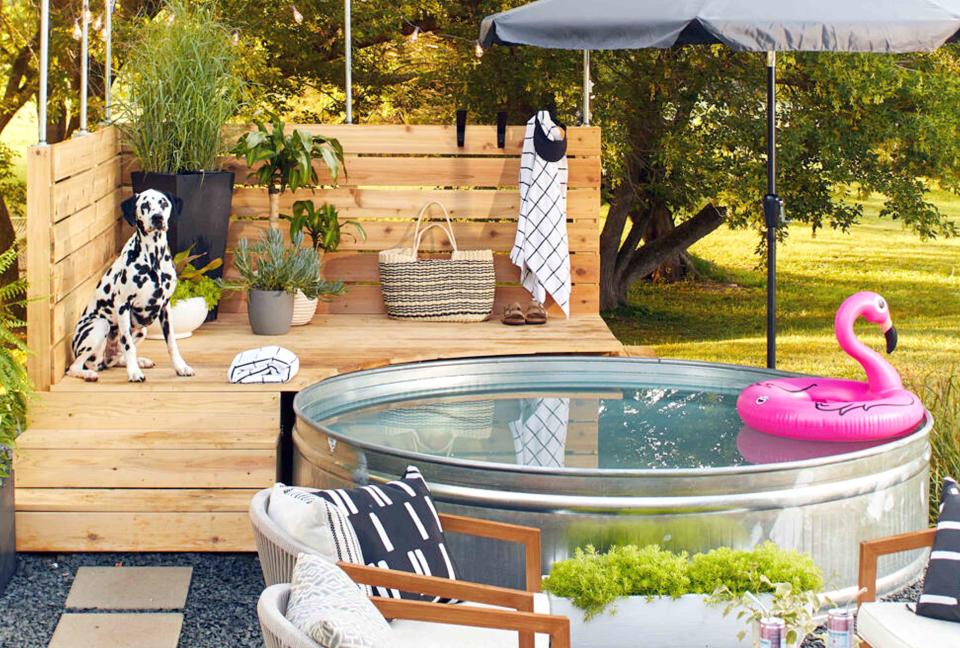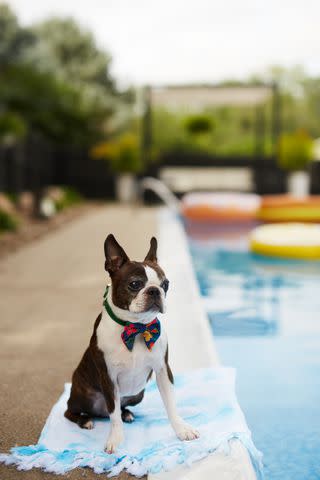DIY Dog Pools Are the Perfect Way to Pamper Your Pooch This Summer
We break down the details, including whether you need a permit to tackle this pet-friendly project.

Marty Baldwin
There are a variety of reasons to consider installing a DIY dog pool this summer. Just like people, dogs get hot too, and cooling off with a nice wade in the pool can be quite appealing. Beyond that, it can also have health benefits, says Nicole Ellis, Certified Professional Dog Trainer and member of Rover’s Pet People Panel.
“Swimming is very beneficial to dogs as it strengthens their joints while simultaneously taking their weight off of their joints,” she explains. “This can help reduce pain and improve range of motion, in addition to helping with circulation and reducing inflammation.” Not to mention, water play is great exercise. “Just one minute of swimming equals four minutes of running with your dog, but without weight on their joints,” Ellis says.
If your pup isn’t one for doggy paddling, the benefits of wading pools can also help with joint health and simply cool your pet when temperatures soar. To get started on your DIY dog pool, we’ve gathered what you should know before jumping in.
Related: 7 Pet-Friendly Interior Design Ideas Your Furry Friend Will Love
Do You Need a Permit for a Dog Pool?
One thing to determine before embarking on a DIY dog pool is whether the scope of your job requires a permit. Mallory Micetich, home expert at Angi, says it will mostly come down to size. “If your dog pool is small and removable, you probably don’t need to get a permit,” she says. Check your city’s website to see the list of permit-requiring projects. “If you still aren’t sure, you can call your local permitting office just to be safe,” she advises.
When to Hire a Professional to Install a Dog Pool
Whether you’re a relatively experienced DIYer or a true novice, you might want to reach out to a handyman to assist with your DIY dog pool, particularly if you’re taking on a larger above-ground pool or tackling a built-in pool. “If your dog pool is more complicated or has advanced features, you may need to hire a more specific pro,” says Micetich. “For example, if you want your dog pool to be surrounded by decking, you should bring in a decking pro to help with your project.”

REBEKAH PHOTOGRAPHY
Dog Pool Design Considerations
Ellis suggests thinking about your dog’s water habits when designing your DIY dog pool. “Some dogs don't love swimming, but love standing in the shallow area, so it’s important to think about what they will enjoy and use the most,” she says. “It’s also important to be sure your dog has an access point they can easily find and get out of, and remember to use materials that won’t easily get punctured by dog nails.”
Now that we’ve covered the basics, there are a few different dog pool types to consider.
Dog Stock Tank Pool – A stock tank pool is made of a galvanized steel tub. They come in a variety of sizes and depths, though a short-walled option that your dog can easily step into and get out of is ideal for a quick cool down to beat the summer heat. Its manageable size also makes cleaning and filling less arduous.
Built-In Dog Pool – A built-in pool will likely require a more experienced DIYer or professional. These pools are meant to lay flat against the lawn and are permanent insofar as they can’t be relocated. Opting for a zero-entry design makes getting in and out of the pool easier for your pet and also allows them to wade until their heart’s content.
Above-Ground Dog Pool – Just like built-in pools and stock pools, above-ground pools come in all shapes and sizes ranging from tiny plastic kiddie pools (technically, an above-ground pool) to large steel-framed versions. To give your above-ground pool a more permanent feel or help your dog more easily get into and out of it, consider building a small deck around the perimeter. Pay particular attention to ensuring your dog is able to climb out of the pool easily as many above-ground pools feature flat sides and ladders for climbing in and out.
Related: The 8 Best Above-Ground Pools for Your Backyard
Dog Pool Safety
Ensuring the safety of your pets around your DIY dog pool is just as important as other forms of water safety. Ellis suggests beginning your safety protocols by checking construction to ensure there are no sharp edges that could potentially injure your dog. “It’s also important to have a barrier up so that pets (and humans) won’t accidentally fall into the pool, which can be quite dangerous,” says Ellis. In addition, it allows you to decide when your dog goes for a swim—something you might not want him to do every time he pops out to the backyard.
Ellis says that chlorine is considered safe for dogs as long as you don’t use more than the recommended amount for the size of your pool. Check the levels regularly to make sure you’ve struck the right balance. “Using too much can be dangerous to your dog’s sensitive eyes, ears, and skin,” she says. If you opt to use water from your hose to fill the pool, you’ll also want to keep in mind that it might come along with bacteria that you won’t want your dog to ingest large amounts of while taking his swim. Have them come out of the water for regular water breaks so they don't get dehydrated—or decide to start lapping up the pool water.
Be sure to remove any pool toys after the swim so they can dry out properly and reduce bacteria growth. Ellis says it’s important for your pet to properly dry off, too, in order to avoid ear and skin infections.
How to Clean and Maintain a Dog Pool
Keeping your DIY dog pool clean starts with your pup. “Brushing your dog prior to swimming will help remove loose fur and dirt before they jump into the water,” says Ellis. From there, the pet pro says it’s best practice to clean the water after each swim as this can cut down on bacteria buildup while also reducing fur accumulation that could clog your filters. “Dog skin and fur can also increase the level of phosphates in pools, so be sure to regularly check your pH levels,” Ellis says.
For more Better Homes & Gardens news, make sure to sign up for our newsletter!
Read the original article on Better Homes & Gardens.

